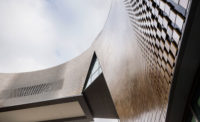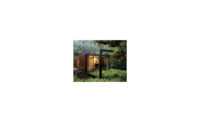In 2014, Fast Retailing, one of the world’s leading apparel companies, decided to move its headquarters and flagship creative studio to the top floor of an existing warehouse in a growing waterfront area of Tokyo. Best known for its fast-fashion brand Uniqlo, the company has competed with international apparel companies such as Zara from Spain and H&M from Sweden. In today’s world, where consumers can easily access products online, however, the walls between industries have disappeared, and Fast Retailing realized that its competition has extended not only to sports apparel and e-commerce companies but to enterprises that provide everything else that consumers might want.
Additional Content:
Jump to credits & specifications
Before moving to their new headquarters in the Ariake District on Tokyo Bay, various departments at Fast Retailing operated separately—both physically and psychologically—in typical compartmentalized office environments with low ceilings and a few glazed meeting rooms. To survive in the new era, the company set a goal to completely transform its work culture to one in which information can seamlessly flow from planning to distribution to sales, inspiring the employees’ creativity and increasing the efficiency of operation. The company’s global creative director, John C. Jay, formerly a partner at Wieden+Kennedy, approached Brad Cloepfil of Allied Works Architecture—whose design of W+K’s headquarters in Portland, Oregon, initiated a creative breakthrough for the advertising agency—to discuss the design of the new headquarters and creative studio.
The resulting single-floor office, spanning four acres, accommodates more than 1,000 employees from around the globe who are in charge of R&D, design, marketing, merchandising, and management, and work collaboratively to deliver new products and services. The 242-by-830-foot floor plan, resembling a city block of Manhattan, draws from the organizational logic of an urban center. For example, a “street” runs through the middle of the floor, connecting the entire office from north to south. To impart a human scale to the gigantic proportions of the warehouse, the meandering street is punctuated by social “nodes,” such as a digital-information center called Answer Lab, a reading room, a dining room, and a Great Hall for company-wide gatherings. Employees are free to work in any of these nodes or other, smaller areas with chairs and couches. In fact, the entire floor, including the street, is their workplace.
The street has a ceiling height of almost 16 feet, with skylights—specially developed with the building’s designer, Daiwa House Industry, to be used in an industrial structure—that give people the sense of walking along a busy avenue. Facing the street, “porches” with couches and tables for informal meetings, along with larger gathering spaces at the nodes, stimulate people to move around, be seen by others, and exchange information regardless of departments or job titles.
Employees enter the light-filled work lofts—open office or studio areas—through these porches. Taking advantage of the expansive floor plate, the lofts are partitioned by lounges, ateliers, and columns placed on a 30-by-36-foot grid, so employees can see the activities of their colleagues. This arrangement also provides flexibility, so spaces can be reconfigured to respond to changing needs that can crop up during product development.
Larger spaces—a dining room at the northwest corner and the Great Hall at the opposite corner—act as town squares, encouraging employees to move the entire length of the floor. The Great Hall allows the company for the first time in its history to gather all of its employees together for presentations and product reviews. It also can hold various types of events like fashion shows and ceremonies for new employees. On a daily basis, the space can be divided for smaller work sessions.
Uniqlo aims to provide its customers around the world with casual wear that can enrich their everyday lives at affordable prices. To do this in a fast-paced, digital era, the company needed to develop a new work style where all employees can communicate easily or freely, work in small teams, and instantly respond to customers’ needs.
Fast Retailing’s CEO Tadashi Yanai asked Cloepfil and his team at Allied Works to transform not only the work environment for his employees but also challenge the more restricted work culture in Japan. The idea of working in a place where employees are free to claim various spots as their workplace embodies a possibility that could be applied beyond a single office project to others in the city as a whole. As the architect states, his collaboration with Fast Retailing “has resulted in the creation of a new design paradigm for what a workspace can be.”
Back to Good Design Is Good Business 2018
CreditsArchitectL Brad Cloepfil Allied Works 1532 SW Morrison, 3rd Floor Portland, OR 97205
Personnel in architect's firm who should receive special credit: Brad Cloepfil, Kyle Lommen, Thea von Geldern, Yuri Suzuki, Rashmi Vasavada, Brent Linden, Rebecca Wood, Rachel Schopmeyer, Bjorn Nelson, Emily Kappes, Daniel Martinez, Alexis Kurland, Minh LeDao
Architect of record: Allied Works Architecture
Interior designer: Allied Works Architecture
Engineers: Structural, envelope: Arup Civil: Daiwa House MEP: Nomura
Consultants: Landscape: Kosugi Furniture delivery: Workplace Soultions Inc. Lighting: Endo Shomei
General contractor: Local architect and TI contractor: Nomura Core and shell contractor: Daiwa House
Photographer: Kenji Takahashi, Nacasa and Partners |
SpecificationsCeiling Asahi Fiber Glass Company
Demountable partitions Komatsu Wall Industry
Flooring Interface (carpeting); Kasthall (rugs)
Furnishings Okamura; Ritzwell; Maruni; Bo Concept
Lighting Endo Lighting Corporation |













Post a comment to this article
Report Abusive Comment